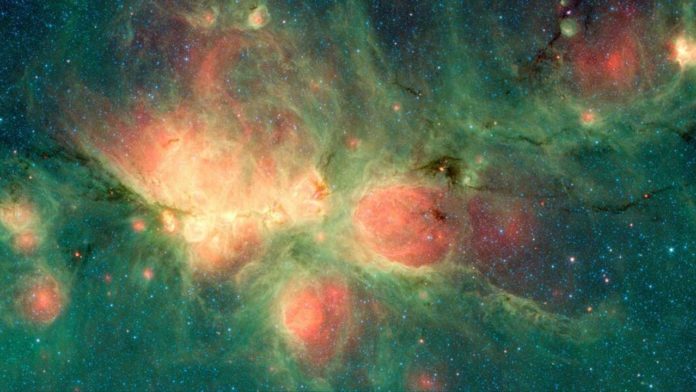At a distance of some 4,240 light-years away, astronomers have discovered an emission nebula and star-forming region dubbed the Cat’s Paw Nebula as part of the B-field In STar-forming Region Observations (BISTRO) survey. This discovery offers essential information about the structure of the object’s complex magnetic field.
Also known as NGC 6334 or Gum 64, the Cat’s Paw Nebula is a high-mass star-forming complex that lies within the galactic plane. It has a kind of a filamentary cloud structure spanning 1,000 light-years and hosts several star-forming regions.
Observations show that NGC 6334 is overwhelmed by both a dense ridge threaded by sub-filaments and two hub-like structures towards its Northeast end. Astronomers have discovered that this edge itself is in the process of active high-mass star formation, and ultra-compact HII regions, maser sources, and molecular outflows have been identified along or next to the crest. Notwithstanding, in spite of the fact that column density and velocity structures of the nebula’s, both filaments and hubs have been thoroughly examined, still very little is known about its magnetic field (B-field).
To advance our knowledge in this matter, a group of astronomers led by Doris Arzoumanian of the University of Porto, Portugal, analyzed observations of the dust polarized emission at 850µm obtained with the SCUBA-2/POL-2 instrument of the James Clerk Maxwell Telescope (JCMT).
Scientists noted, “To gain insight into the B-field structure along dense filaments and improve our understanding of the role of the magnetic field in the star formation process, we analyze new 850µm data obtained towards the NGC 6334 star-forming filamentary region observed as part of the B-field In STar-forming Region Observations (BISTRO) using SCUBA-2/POL-2 installed on the James Clerk Maxwell Telescope (JCMT).”
The observations revealed that NGC 6334 showcases a complex B-field structure when seen over the whole region (around 33 light-years); in any case, at smaller scales, the plane-of-the-sky (POS) B-field angle varies coherently along the crests of the filament network.
When astronomers investigated the variation of the polarization and physical properties along the sub-filaments from their outer to their inner parts, they found that the POS magnetic field shows mostly perpendicular or random orientation in the outer parts with respect to the sub-filament crests. In contrast, in the inner parts, the B-field is parallel to their crests.
Such change of relative orientation along the sub-filaments may be due to material flowing along their crests onto the ridge and hubs.
The results also pointed out that a variation of the energy balance along the crests of these sub-filaments, from magnetically critical/supercritical at their far ends to magnetically subcritical near the ridge and hubs. The study also detected an increase of polarized fraction toward the high-column density star cluster-forming hubs.
Scientists noted, “further monitoring of NGC 6334, mostly higher angular resolution observations, which could be crucial to understand better the role of the magnetic field in the matter assembly and fragmentation processes that lead to the formation of massive stars.”
Journal Reference:
- Dust polarized emission observations of NGC 6334, arXiv:2012.13060 [astro-ph.GA] arxiv.org/abs/2012.13060
